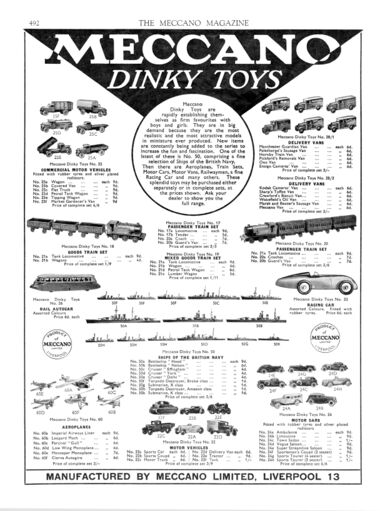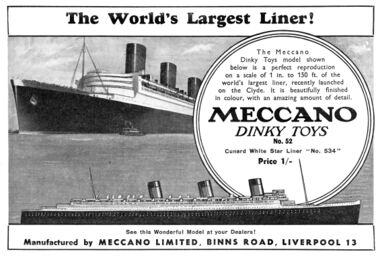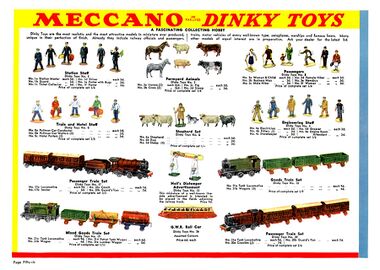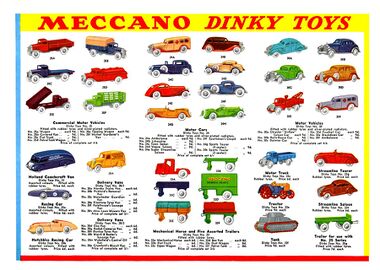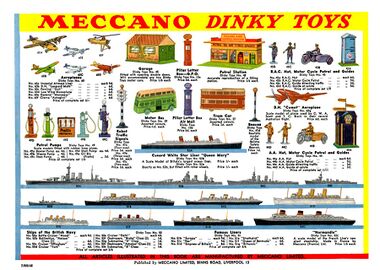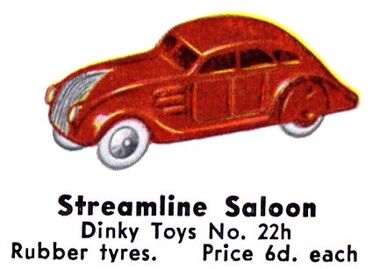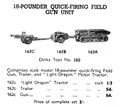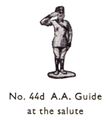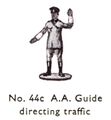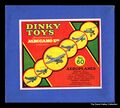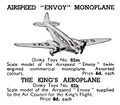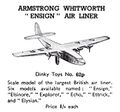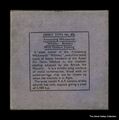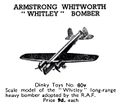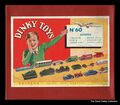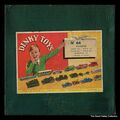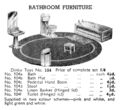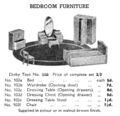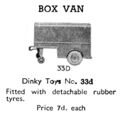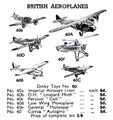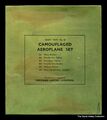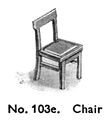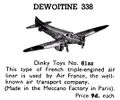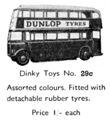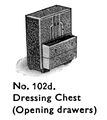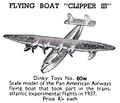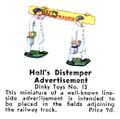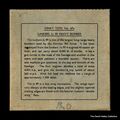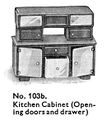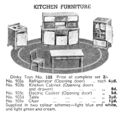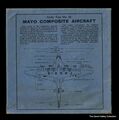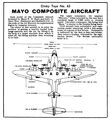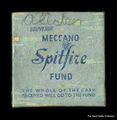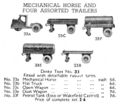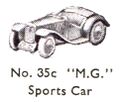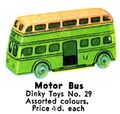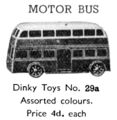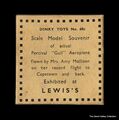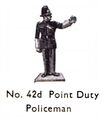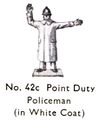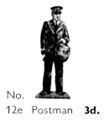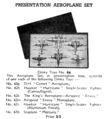Category:1930s Dinky Toys
Meccano/Hornby/Dinky :
Modelled Miniatures | Dinky Toys | Supertoys | Dinky Builder | Dublo Dinky |
Army | Boats | Dollhouse | Farm | Planes · 1 · 2 · 3 | Ships |
US FR 1930s | 1940s | 1950s | 1960s | 1970s |
June 1934: Full-page advert in Meccano Magazine.
Note that the "Meccano" logo is substantially largr than the "Dinky" logo. [image info]
October 1934: The largest Dinky ship in 1934 - the Queen Mary [image info]
1935: Dinky Toys range, "200 Varieties", "A fascinating Collecting Hobby" page 1. The "Meccano" and "Dinky" logos are now the same height. [image info]
1935: Dinky Toys range, page 2 [image info]
1935: Dinky Toys range, page 3 [image info]
Dinky 22h Streamlined saloon, 1935 catalogue [image info]
When the Hornby Modelled Miniatures range was relaunched in early 1934 as Dinky Toys, it was with a big investment in design and advertising.
Branding
The new "Meccano Dinky Toys" initially led with the Meccano name as a reassuring "known" umbrella brand, but as it soon became well-enough known to be marketed independently, transitioning from "MECCANO Dinky Toys", to "DINKY TOYS by Meccano", to just "Dinky Toys".
Initial problems with MAZAK
After the very first pieces (such as the first version of the delivery vans), casting was switched from lead to "MAZAC", a tougher and lighter metal alloy better suited to standing up to harsher treatment (which was especially important if thin parts of the moulding were to be holding wheel axles in place). The experimental nature of these new casting processes led to some severe production problems, where stresses and strains frozen into the castings caused some models to warp and twist over time, with some falling apart before they even reached the shops (the current theory is that some of this variation in the MAZAC mix properties was due to workers throwing scrap metal into the vats). These teething problems were eventually resolved, but it's not unusual to find that some of the oldest, long and thin pieces from the period (such as the ships) have warped and broken up over the years ("banana-ing"), creating more of a price premium for nicely-cast unwarped versions of some of the more damage-prone pieces.
On the other hand, the difficulty of moving to these new casting techniques (and setting aside the tried and tested lead-casting methods) meant that better-established and more conservative metal toy casting companies such as W. Britain) tended to stay with lead, and with pieces with no moving parts, and as a result, Dinky had the British diecast metal vehicles"market pretty much to itself during this period.
Speedy expansion
The speed at which the range expanded can be seen from the advertising - initially "150 models", then "250 models", and "300 models" shortly thereafter.
Range
The 1930s Dinky range seemed to be designed to include a bit of everything: Passengers and famyard animal figures for gauge 0 model railways, waterline ships, aeroplanes, under-size (for gauge 0) cars, and even small tabletop "floor toy" toy trains.
As the range icreased in sized, it incorprorated more road vehicles, a garage and pertol station, petrol station pumps, postboxes, a small double decker bus and tram, and AA/RAC/Police figures, motorcyclists and their huts (and a police box).
There was also a brief foray into Dinky Toys Dollhouse Furniture, to go with a leatherboard collapsable "[[Dolly Varden]" dollhouse, but this doesn't seem to have been a huge success, partly because of Meccano Ltd's odd decision not to use a standard 1:12 or 1:16 dollhouse scale.
As the Second World War loomed in 1939, the Dinky range developed a range of army vehicles in drab green, which expanded during 1940.
1934 promotional text:
Meccano Dinky Toys are rapidly establishing themselves as firm favourites with boys and girls. They are in big demand because they are the most attractive models in miniature ever produced. New items are constantly being added to the series to increase the fun and fascination. One of the latest of these is No. 50, comprising a fine selection of Ships of the British Navy.
Then there are Aeroplanes, Train sets, Motor cars, Motor Vans, Railwaymen, a fine Racing Car and many others. These splendid toys may be purchased either separately or in complete sets, at the prices shown. Ask your dealer to show you the full range.
— , Meccano Ltd., , Meccano Magazine, , June 1934
1934 Meccano Magazine article:
Collecting Meccano Dinky Toys
A New and Fascinating Hobby
THERE is a peculiar fascination about miniature reproductions of familiar things. We pay little attention to the normal full-sized objects to be seen every day in our strects and elsewhere, but a miniature reproduction of one of them immediately attracts our notice, and most of us feel a desire to possess it!
Some years ago a set of platform accessories — luggage and truck, milk cans and truck, seats, and automatic machines – was introduced with the object of making Hornby Station platforms more realistic. This proved immediately popular, but Hornby RaiIway owners were not satisfied. They demanded miniature railwaymen and passengers to give "life" to the platforms, and in response to this demand two further sets of figures were produced, one consisting of station staff and the other of typical passengers. Miniature train sets followed, each made up of a locomotive and two or three coaches or goods vehicles.
The requirements of railway enthusiasts were thus fairly well provided for, but nothing had been done for those whose interests lay in other directions. We were repeatedly asked for other miniatures, mainly of motor cars, aeroplanes and ships; and finally it was decided to introduce a comprehensive series of models under the general title of Dinky Toys. This series met with an enthusiastic welcome, and it bas been rapidly extended until it now includes well over one hundred items, with many others in active preparation.
The Dinky Toys form the most attractive set of miniatures in existence. They are well designed and beautifully finished in colour, and they include the utmost amount of detail possible in such tiny reproductions. All of them form delightful ornaments for table or mantelpiece, especially if arranged in sets. In addition many of them can be used with striking effect in Hornby Railway layouts, to which they add a remarkable touch of realism. This is especially the case with layouts incorporating some of the Countryside Sections. Horses, cattle and sheep can be placed in the fields, and pedestrians and motor vehicles of various types distributed at suitable points along the roads. The effects that can be produced in this manner are quite extraordinary, and the general scheme can be varied almost indefinitely.
With a few exceptions all the Dinky Toys are arrangcd in sets, but every item can be purchased separately. One of these sets, or even a single mode!, forms an ideal Christmas present.
The train sets, of which there are four, have already been mentioned, Set No. 17 consists of a locomotive and tender, coach and guard's van, and Set No. 20 of a tank locomotive, two coaches and guard's van. For those who prefer goods trains there are Sets No. 18, consisting of a tank locomotive and three open wagons, and No. 19, comprising a tank locomotive, an open wagon, a petrol tank wagon and a lumber wagon. By purchasing additional coaches or wagons these trains can be increased to quite impressive proportions, and as all the items are to the same scale the trains can be rearranged and made up in any way desired.
Motor car enthusiasts are particularly well catered for. Set No. 24 alone includes seven different types of up-to-date private cars, ranging from a sports two-seater to a handsome limousine, together with a splendid model of a typical ambulance. All these vehicles are fitted with rubber tyres and silver-plated radiators. Then there is Set No. 25, which provides an equally attractive collection of commercial vehicles. There are six of these, an open wagon, a flat truck, a covered van, a petrol tank wagon, a market gardener's van, and a tipping wagon that actually tips!
Another interesting model is the Racing Car (No. 23). This is a realistic little model of a typical modern speed car. It is fitted with rubber tyres and is obtainable in a variety of attractive colours. Even more striking is the "Airfiow" Saloon (No. 32). This is an exceptionally handsome mode!, which demonstrates excellently the principles of streamlining. It is fitted with rubber tyres, silver-plated radiator and bumpers, and is obtainable in various colours. Still another very attractive vehicle is the "Holland Coachcraft" van (No. 31). This is a model of one of the most modernistic commercial vehicles now on the road. Turning now to aeroplanes, we find six splendid models in Set No. 60. The largest of these is a realistic reproduction of an Imperial Airways liner, which gives a good idea of the massive proportions and handsome appearance of these machines. Smaller but equally attractive are the models of a D.H. "Leopard Moth," a Percival "Gull," a low wing monoplane, and a General "Monospar." Finally there is a delightful little model of a Cierva "Autogiro." This tiny model, with its revolving vanes, has proved exceptionally popular, which shows clearly not only the high quality of the model, but also the widespread interest that is now being taken in this type of aeroplane.
One of the outstanding events of 1934 was the launch of the giant Cunard White Star Liner "Queen Mary" on 26th September. This ship has attracted more attention than any other vessel built for many years, and therefore it is fitting that a special model should be included in the Dinky Toys series. This model (No. 52) is designed to a scale of 150 ft. to 1 in., and is nearly 7 in. in length. It contains a surprising amount of intricate detail work, particularly in the boat deck and the superstructure generally. It is finished in correct colours and shows how the real "Queen Mary" will appear when she is completed and ready for her maiden voyage in the early part of 1936. Then, everyone hopes, she will recover for Great Britain the much coveted "Blue Riband" of the Atlantic.
Set No. 51 includes six liners of world-wide fame. There is Nord-deutscher Lloyd "Europa," and the Italian liner "Rex," which at present holds the Atlantic record with a crossing between Gibraltar and New York made in four days 13 hours. Coming now to British ships, there is the C.P.R. "Empress of Britain," the P. & O. "Strathaird," the Furness Withy "Queen of Bermuda" and the Cunard White Star "Britannic."
All these ships are what are known as "waterline" models; that is to say, they represent the vessel as she appears in the water when loaded down to her normal level. It is impossible to convey in words any adequate impression of the daintiness of these models. They include every detail for which room could be found, and they are beautifully finished in correct colours.
All boys are interested in warships, and Set No. 50 provides a set of ships of the British Navy ranging from battleships to submarines. Heading the Set are the mighty battle cruiser "Hood" and the battleship "Nelson." Then there are three typical cruisers, "Effingham," "York" and "Delhi," and two destroyers of the "Broke" and "Amazon" classes respectively. Smallest of all are models of submarines of the "X" and "K" classes. All these warships are painted in battleship grey, with a dull matt finish that gives a strikingly realistic
appearance. Keen boys will appreciate the fact that the gun turrets on the cruisers and battleships, although so small, will actually swivel!
The Dinky Toy ships are just the thing for giving the finishing touches to models of harbours and docks. Large models of this nature are very popular just now with Meccano Clubs, and they look astonishingly realistic with one or two Dinky Toy liners at the quayside. The effect is enhanced by a small fleet of warships lying at anchor in the "roadstead."
From this necessarily brief survey it will be evident that the Meccano Dinky Toys provide ail the material for a fascinating collecting hobby. The range of subjects is an great as to provide ample variety, and as many of the models can be obtained in several different colours, there is scope for an extensive collection of outstanding interest. The Dinky Toys that are now in preparation will be announced in the pages of the "M.M." immediately they are available, and collectors should keep a sharp look-out for details.
In next month's "MM." we hope to include an article describing in detail how Meccano Dinky Toys can be put to use in the fascinating hobby of table-top photography. This hobby consists of arranging on a table miniature scenes, composed of tiny models and scrap material of all kinds. These scenes are then photographed, and the results appear as though they were quaint reproductions of real scenes. A great deal of the fun in this kind of photography lies in making use of the simplest of household articles to produce realistic effects, and in next month's article we shall describe some of the unlimited possibilities in this direction.
One difficulty in the past has been that the household material available has usually been seriously deficient in models small enough to be used for the purpose. This problem is now solved by the appearance of the Dinky Toys. The motor cars and wagons lend themselves perfectly to the production of realistic road scenes; the trains provide the necessary railway material, and the ships make it possible to produce harbour or coastal scenes in great detail. The aeroplanes, too, can be made to play an important part, and in the article special reference will be made to their employment.
No doubt keen and enthusiastic readers will discover other interesting uses for the Dinky Toys, and we should be glad to receive descriptions and if possible photographs of any such schemes.
— , -, , Meccano Magazine, , December 1934
Packaging
The early Dinky packaging inherited the emphasis on sets from the Modelled Miniatures ranges, where pieces were typically organised into numbered sets of six, with the pieces within a set distinguished with a letter, so for instance, Dinky Set No.2 was a set of six farmyard animals (2a-2f), in a cardboard box, but if you wanted to buy a pig (2c) separately, you didn't get a box.
Dinky extended this even to models that didn't obviously form simple sets - if you wanted to buy a standard-sized Dinky car, the retailer would buy them in boxed packs of six, and you'd be sold your individual car "loose".
Pre/PostWar
The range produced in the 1930s tends to be referred to as the "prewar" Dinky range, and since only a few new sets were issued in 1940-45, these tend to be lumped together with the 1930s "prewar" sets – even though they were technically produced during the war, they can be considered the "stragglers" of the 1930s range, appearing just before World War Two (1939-1945) finally shut down production.
See also:
Subcategories
This category has the following 15 subcategories, out of 15 total.
A
- Aeroplane Set (Dinky Toys 64) (empty)
- Aeroplane Set (Dinky Toys 65) (1 P, 1 F)
B
- British Aeroplanes (Dinky Toys 60) (6 P, 8 F)
D
- Delivery Vans (Dinky Toys 28, first casting) (6 P, 19 F)
- Dollhouse furniture, Bathroom (Dinky Toys 104) (4 P, 6 F)
F
- French Aeroplanes (Dinky Toys 60z) (1 P, 1 F)
- French Aeroplanes (Dinky Toys 61z) (1 P, 1 F)
M
R
- RAF Aeroplane Set (Dinky Toys 61) (1 P, 1 F)
Pages in category ‘1930s Dinky Toys’
The following 81 pages are in this category, out of 81 total.
A
B
C
- Caravan Trailer (Dinky Toys 30g)
- Cierva Autogiro, blue and yellow (Dinky Toys 60f)
- Cierva Autogiro, gold and red (Dinky Toys 60f)
- Cierva Autogiro, silver and red (Dinky Toys 60f)
- Cierva Autogiro, yellow and green (Dinky Toys 60f)
- Cierva Autogiro, yellow and red (Dinky Toys 60f)
- Covered Wagon (Dinky Toys 25b)
E
F
- Farmyard Animals (Dinky Toys 2)
- Flat Truck (Dinky Toys 25c)
- Four Engine Flying Boat G-EXFE, gold (Dinky Toys 60m)
- Four Engine Flying Boat G-EXGF, blue (Dinky Toys 60m)
- Four Engine Flying Boat G-EXGF, red (Dinky Toys 60m)
- Four Engine Flying Boat G-EYCE, green (Dinky Toys 60m)
- Four Engine Flying Boat with rollers, trade box (Dinky Toys 60m)
H
I
L
M
P
- Percival Gull, blue and white (Dinky Toys 60c)
- Percival Gull, red and blue (Dinky Toys 60c)
- Percival Gull, yellow and red (Dinky Toys 60c)
- Petrol Pumps (Dinky Toys 49)
- Petrol Station (Dinky Toys 48)
- Petrol Tank Wagon "Castrol" (Dinky Toys 25d)
- Petrol Tank Wagon (Dinky Toys 25d)
- Pickfords Van (Dinky Toys 28b-1)
- Pillar Letter Box GPO (Dinky Toys 12a)
- Pillar Letter Box GPO, light red (Dinky Toys 12a)
S
- Saloon Car (Dinky Toys 35a)
- Sharp's Toffee Van (Dinky Toys 28h-1)
- Shepherd Set (Dinky Toys 6)
- Ships of the British Navy (Dinky Toys 50)
- Silver Jubilee streamlined train (Dinky Toys 16)
- Singapore Flying Boat (Dinky Toys 60h)
- Singapore Flying Boat, boxed (Dinky Toys 60h)
- Streamlined Bus (Dinky Toys 29b)
- Streamlined Diesel Articulated Train (Dinky Toys 16z)
- Streamlined Fire Engine (Dinky Toys 25h)
Media in category ‘1930s Dinky Toys’
The following 200 files are in this category, out of 287 total.
(previous page) (next page)- 18-Pounder Quick-Firing Field Gun Unit, Dinky Toys 162 (HamleyCat 1939).jpg 2,181 × 761; 603 KB
- AA Guide at the salute, Dinky Toys 44d (MM 1936-06).jpg 580 × 631; 25 KB
- AA Guide directing traffic, Dinky Toys 44c (MM 1936-06).jpg 580 × 628; 28 KB
- AA Hut, Dinky Toys 44a (MM 1936-06).jpg 710 × 1,022; 76 KB
- AA Hut, Motor Cycle Patrol and Guides, Dinky Toys 44 (1935 BoHTMP).jpg 863 × 663; 119 KB
- AA Motor Cycle Patrol, Dinky Toys 44b (MM 1936-06).jpg 922 × 555; 44 KB
- Aeroplane Set, box lid (Dinky Toys 64).jpg 3,000 × 1,886; 976 KB
- Aeroplanes set, box lid (Dinky Toys 60).jpg 3,000 × 2,693; 1.78 MB
- Airspeed Envoy Monoplane, Dinky Toys 62m 62k (MeccanoCat 1939-40).jpg 1,324 × 1,154; 197 KB
- Ambulance, Dinky Toys 24a (1935 BoHTMP).jpg 496 × 252; 22 KB
- Ambulance, Dinky Toys 30f (1935 BoHTMP).jpg 449 × 277; 21 KB
- Amiot 370 monoplane, Dinky Toys 64az (MCat 1939).jpg 1,453 × 1,021; 131 KB
- Armstrong Whitworth Ensign Air Liner, Dinky Toys 62p (MeccanoCat 1939-40).jpg 1,242 × 1,159; 163 KB
- Armstrong Whitworth Whitley Bomber, box lid (Dinky Toys 62t).jpg 2,981 × 3,000; 1.53 MB
- Armstrong Whitworth Whitley Bomber, Dinky Toys 60v (MeccanoCat 1939-40).jpg 1,175 × 1,040; 129 KB
- Auto-Union Racing Car, Dinky Toys 23d (MM 1936-06).jpg 941 × 685; 87 KB
- Avions set, French, box lid (Dinky Toys 60).jpg 3,000 × 2,629; 1.66 MB
- Avions set, French, box lid (Dinky Toys 64).jpg 3,000 × 2,988; 1.83 MB
- Bath and Bath Mat, Dinky Toys 104a 104b (MM 1936-07).jpg 1,120 × 855; 200 KB
- Bathroom Furniture set, box lid (Dinky Toys 104).jpg 2,200 × 1,494; 713 KB
- Bathroom Furniture, Dinky Toys 104 (1939 catalogue).jpg 753 × 688; 91 KB
- Battle Cruiser Hood, Dinky Toys 50a (1935 BoHTMP).jpg 1,042 × 305; 41 KB
- Beacon, Dinky Toys 47d (MM 1936-06).jpg 553 × 1,010; 45 KB
- Bed, Dinky Toys 102a (MM 1936-07).jpg 1,276 × 910; 237 KB
- Bedroom Furniture set, box lid (Dinky Toys 102).jpg 2,200 × 1,327; 801 KB
- Bedroom Furniture, Dinky Toys 102 (1939 catalogue).jpg 775 × 750; 91 KB
- Belisha Safety Beacon, Dinky Toys 47d (1935 BoHTMP).jpg 250 × 610; 19 KB
- Bloch 220 airliner, Dinky Toys 64bz (MCat 1939).jpg 1,481 × 801; 105 KB
- Boeing Flying Fortress Monoplane, DInky Toys 62g (MeccanoCat 1939-40).jpg 1,278 × 759; 133 KB
- Bowser Pump, Dinky Toys 49a (1935 BoHTMP).jpg 282 × 384; 15 KB
- Box Van, Dinky Toys 33d (1935 BoHTMP).jpg 438 × 311; 24 KB
- Box Van, Dinky Toys 33d (MCat 1939).jpg 856 × 841; 65 KB
- Breakdown Car, Dinky Toys 30e (1935 BoHTMP).jpg 452 × 302; 20 KB
- Breakdown Car, Dinky Toys 30e (MCat 1939).jpg 451 × 345; 24 KB
- British Aeroplanes, Dinky Toys 60 (MeccanoCat 1939-40).jpg 1,342 × 1,423; 238 KB
- Camouflaged Aeroplane Set, box lid (Dinky Toys 66).jpg 2,679 × 3,000; 1.29 MB
- Captain G E T Eyston Thunderbolt, box lid (Dinky Toys 23m).jpg 3,000 × 1,159; 581 KB
- Caravan Trailer, Dinky Toys 30g (MCat 1939).jpg 499 × 347; 24 KB
- Caravan Trailer, Dinky Toys 30g (MM 1936-06).jpg 1,145 × 841; 117 KB
- Carver Chairs, Dinky Toys 101c (MM 1936-07).jpg 1,036 × 717; 126 KB
- Castrol Delivery Van (Dinky Toys).jpg 400 × 299; 68 KB
- Chair, Dinky Toys 102f (MM 1936-07).jpg 535 × 709; 65 KB
- Chair, Dinky Toys 103e (MM 1936-07).jpg 681 × 745; 78 KB
- Chairs, Dinky Toys 101d (MM 1936-07).jpg 1,627 × 791; 173 KB
- Chrysler 'Airflow' Saloon Car, Dinky Toys 30a (1935 BoHTMP).jpg 449 × 298; 22 KB
- Commercial Motor Vehicles set, box lid (Dinky Toys 25).jpg 3,000 × 2,162; 1.56 MB
- Covered Van, Dinky Toys 25b (1935 BoHTMP).jpg 446 × 280; 22 KB
- Crawfords Biscuit Delivery Van, Dinky Toys 28l 28-2 (MM 1934-07).jpg 1,257 × 868; 210 KB
- Cruiser Delhi, Dinky Toys 50e (1935 BoHTMP).jpg 606 × 219; 28 KB
- Cruiser Effingham, Dinky Toys 50c (1935 BoHTMP).jpg 710 × 265; 25 KB
- Cunard Liner 534, Dinky Toys 52 (MM 1934-10).jpg 2,259 × 1,522; 664 KB
- Cunard White Star Liner Queen Mary, box lid (Dinky Toys No52a).jpg 3,000 × 1,097; 671 KB
- Cunard White Star Liner Queen Mary, Dinky Toys 52a (1935 BoHTMP).jpg 980 × 349; 90 KB
- Daimler Car, Dinky Toys 30c (1935 BoHTMP).jpg 443 × 265; 20 KB
- Delivery Vans sets, Dinky Toys 28-1 28-2 (1935 BoHTMP).jpg 537 × 919; 96 KB
- Delivery Vans, Dinky Toys 28-280 (MCat 1939).jpg 1,597 × 2,741; 561 KB
- Dewoitine 338, Dinky Toys 61az (MeccanoCat 1939-40).jpg 1,069 × 887; 120 KB
- DH 'Comet' Aeroplane, Dinky Toys 60g (1935 BoHTMP).jpg 583 × 313; 50 KB
- DH Comet Aeroplane, Dinky Toys 60g (MeccanoCat 1939-40).jpg 1,081 × 536; 68 KB
- DH Flamingo Liner, Dinky Toys 62f (MeccanoCat 1939-40).jpg 1,051 × 866; 132 KB
- DH Leopard Moth aeroplane, Dinky Toys 60b (1935 BoHTMP).jpg 397 × 237; 15 KB
- Diesel Rail Car, Dinky Toys 26z (MCat 1939).jpg 1,117 × 837; 93 KB
- Dining Room Furniture, Dinky Toys 101 (1939 catalogue).jpg 779 × 595; 73 KB
- Dining-Room Furniture set, box lid (Dinky Toys 101).jpg 2,200 × 1,335; 716 KB
- Dinky Aircraft, p62 (MeccanoCat 1939-40).jpg 1,200 × 806; 201 KB
- Dinky Aircraft, p63 (MeccanoCat 1939-40).jpg 1,200 × 807; 195 KB
- Dinky Aircraft, p64 (MeccanoCat 1939-40).jpg 1,200 × 808; 227 KB
- Dinky aircraft, underside, David Hatley Collection.jpg 2,604 × 649; 242 KB
- Dinky Toys 50, Ships of the British Navy (box art).jpg 800 × 600; 302 KB
- Dinky Toys 52 hull No. 534 (Queen Mary).jpg 800 × 508; 322 KB
- Dinky Toys Dolls House Furniture, and Dolly Varden dollhouse (MM 1936-10).jpg 1,204 × 1,621; 400 KB
- Dinky Toys Dolly Varden Doll's House (1939 catalogue).jpg 1,533 × 2,695; 466 KB
- Dinky Toys Mechanised Units (MM 1939-11).jpg 1,184 × 1,600; 683 KB
- Dinky Toys Revised Prices (MM 1939-11).jpg 1,600 × 509; 477 KB
- Dinky Toys, page 1 (BoHTaMP 1935).jpg 1,200 × 853; 243 KB
- Dinky Toys, page 2 (BoHTaMP 1935).jpg 1,200 × 853; 253 KB
- Dinky Toys, page 3 (BoHTaMP 1935).jpg 1,200 × 853; 285 KB
- Disc Harrow, Dinky Toys 27h (MM 1951-05).jpg 389 × 322; 17 KB
- Double Deck Bus, Dinky Toys 29c (MCat 1939).jpg 763 × 829; 87 KB
- Douglas DC-3 Air Liner, Dinky Toys 60t (MeccanoCat 1939-40).jpg 1,178 × 798; 107 KB
- Dressing Chest, Dinky Toys 102d (MM 1936-07).jpg 805 × 903; 128 KB
- Dressing Table and Stool, Dinky Toys 102c 102e (MM 1936-07).jpg 886 × 1,313; 190 KB
- Dust Wagon, Dinky Toys 33e (1935 BoHTMP).jpg 431 × 260; 21 KB
- Electric Cooker, Dinky Toys 103c (MM 1936-07).jpg 681 × 959; 140 KB
- Empire Flying Boat, Dinky Toys 60r (MeccanoCat 1939-40).jpg 1,181 × 882; 141 KB
- Empire Flying Boats, box lid (Dinky Toys 60r).jpg 2,429 × 3,000; 1.21 MB
- Engineering Staff, Dinky Toys 4 (MCat 1939).jpg 1,404 × 929; 102 KB
- Engineering Staff, Dinky Toys No 4 (1935 BHTMP).jpg 889 × 427; 57 KB
- Ensign Cameras Delivery Van, Dinky Toys 28e 28-1 (MM 1934-07).jpg 1,257 × 868; 203 KB
- Farmyard Animals, box lid (Hornby Series Modelled Miniatures 2).jpg 3,000 × 1,967; 940 KB
- Farmyard Animals, Dinky Toys 2 (MCat 1939).jpg 1,390 × 844; 102 KB
- Farmyard Animals, Dinky Toys No 2 (1935 BHTMP).jpg 835 × 491; 55 KB
- Fiat Two-Seater Saloon, Dinky Toys 35az (MCat 1939).jpg 1,060 × 821; 91 KB
- Flat Truck, Dinky Toys 25c (1935 BoHTMP).jpg 450 × 229; 19 KB
- Flat Truck, Dinky Toys 25c (MCat 1939).jpg 1,043 × 570; 52 KB
- Flat Truck, Dinky Toys 33b (1935 BoHTMP).jpg 484 × 198; 14 KB
- Flying Boat, Clipper III, Dinky Toys 60w (MeccanoCat 1939-40).jpg 1,158 × 997; 155 KB
- French Aeroplanes, Dinky Toys 60z (MeccanoCat 1939-40).jpg 2,161 × 1,119; 241 KB
- French Aeroplanes, Dinky Toys 61z (MeccanoCat 1939-40).jpg 2,151 × 1,124; 245 KB
- French Liner Normandie, Dinky Toys 52c (MM 1936-06).jpg 1,333 × 599; 91 KB
- Garage, Dinky Toys 45 (1935 BoHTMP).jpg 553 × 458; 56 KB
- Garage, Dinky Toys 45 (MM 1935-11).jpg 1,279 × 881; 200 KB
- Gardner MG Record Car, box lid (Dinky Toys 23p).jpg 3,000 × 1,234; 614 KB
- General 'Monospar' aeroplane, Dinky Toys 60e (1935 BoHTMP).jpg 385 × 211; 14 KB
- Gloster Gladiator, box lid (Dinky Toys 60p).jpg 3,000 × 1,783; 889 KB
- Goods Train Set, Dinky Toys No 18 (1935 BHTMP).jpg 1,211 × 423; 72 KB
- GWR Rail Car, Dinky Toys 26 (MCat 1939).jpg 1,125 × 633; 59 KB
- GWR Rail Car, Dinky Toys No 26 (1935 BHTMP).jpg 573 × 379; 29 KB
- Halls Distemper Advertisement, Dinky Toys No 13 (1935 BHTMP).jpg 515 × 511; 39 KB
- Holland Coachcraft Van, Dinky Toys 31 (1935 BoHTMP).jpg 457 × 358; 33 KB
- Hornby Modelled Miniatures (MM 1934-02).jpg 1,215 × 1,600; 392 KB
- Hornby Modelled Miniatures 22f - Army Tank.jpg 1,051 × 651; 82 KB
- Hornby Trains Delivery Van, Dinky Toys 28a 28-1 (MM 1934-07).jpg 1,257 × 868; 209 KB
- Hornby Trains Van, Dinky Toys 28a (1935 BoHTMP).jpg 519 × 302; 22 KB
- Hotchkiss Racing Car, Dinky Toys 23b (1935 BoHTMP).jpg 463 × 308; 28 KB
- Imperial Airways 'Frobisher' Class Liner, Dinky Toys 62w (MCat 1939).jpg 1,457 × 739; 86 KB
- Imperial Airways Liner, Dinky Toys 60a (1935 BoHTMP).jpg 420 × 259; 21 KB
- Junkers Ju 90 Air Liner, Dinky Toys 62n (MeccanoCat 1939-40).jpg 1,242 × 901; 131 KB
- Junkers Ju89 Heavy Bomber, box lid (Dinky Toys 67a).jpg 2,993 × 3,000; 1.44 MB
- Kitchen Cabinet, Dinky Toys 103b (MM 1936-07).jpg 1,037 × 1,163; 278 KB
- Kitchen Furniture set, box lid (Dinky Toys 103).jpg 2,200 × 1,481; 698 KB
- Kitchen Furniture, Dinky Toys 103 (1939 catalogue).jpg 752 × 722; 103 KB
- Kodak Cameras Delivery Van, Dinky Toys 28g 28-2 (MM 1934-07).jpg 1,257 × 868; 204 KB
- Kodak Delivery Van (Dinky Toys 28g).jpg 800 × 600; 288 KB
- La Normandie, box lid (Dinky Toys No52c).jpg 3,000 × 1,065; 742 KB
- Limousine, Dinky Toys 24b (1935 BoHTMP).jpg 511 × 254; 19 KB
- Linen Cupboard, Dinky Toys 104e (MM 1936-07).jpg 561 × 843; 86 KB
- Liner Britannic, Dinky Toys 51g (1935 BoHTMP).jpg 799 × 281; 36 KB
- Liner Empress of Britain, Dinky Toys 51d (1935 BoHTMP).jpg 800 × 284; 51 KB
- Liner Europa, Dinky Toys 51b (1935 BoHTMP).jpg 867 × 244; 45 KB
- Liner Queen of Bermuda, Dinky Toys 51f (1935 BoHTMP).jpg 624 × 237; 37 KB
- Liner Rex, Dinky Toys 51c (1935 BoHTMP).jpg 764 × 224; 39 KB
- Liner Strathaird, Dinky Toys 51e (1935 BoHTMP).jpg 693 × 250; 37 KB
- Low Wing Monoplane, Dinky Toys 60d (1935 BoHTMP).jpg 401 × 237; 15 KB
- Manchester Guardian Delivery Van, Dinky Toys 28c 28-1 (MM 1934-07).jpg 1,257 × 947; 208 KB
- Market Gardeners Van, Dinky Toys 25f (1935 BoHTMP).jpg 452 × 276; 22 KB
- Marsh and Baxters Delivery Van, Dinky Toys 28k 28-2 (MM 1934-07).jpg 1,257 × 985; 231 KB
- Mayo Composite Aircraft, box lid (Dinky Toys 63).jpg 2,969 × 3,000; 1.69 MB
- Mayo Composite Aircraft, box lid artwork (Dinky Toys No63).jpg 2,770 × 3,000; 762 KB
- Mayo Composite Aircraft, Dinky Toys 63 (MCat 1939).jpg 1,444 × 878; 122 KB
- Meccano Delivery Van (Dinky Toys 28n).jpg 800 × 598; 278 KB
- Meccano Delivery Van, Dinky Toys 28n 28-2 (MM 1934-07).jpg 1,257 × 868; 207 KB
- Meccano Dinky Toys (MM 1934-06).jpg 2,431 × 3,267; 920 KB
- Meccano Spitfire Fund pendant, box lid (Dinky Toys 62a).jpg 2,843 × 2,905; 1.64 MB
- Mechanical Horse and Four Assorted Trailers, Dinky Toys 33 (MCat 1939).jpg 1,479 × 1,297; 205 KB
- Mechanical Horse and Four Trailers, box lid (Dinky Toys 33).jpg 3,000 × 1,903; 1.44 MB
- Mechanical Horse, Dinky Toys 33a (1935 BoHTMP).jpg 476 × 247; 16 KB
- Mechanised Army Set, Dinky Toys 156 (MM 1939-11).jpg 1,812 × 1,036; 615 KB
- Mercedes-Benz Racing Car, Dinky Toys 23c (MM 1936-06).jpg 851 × 695; 80 KB
- MG Sports Car, Dinky Toys 35c (MCat 1939).jpg 490 × 317; 24 KB
- MG Sports Car, Dinky Toys 35c (MM 1936-06).jpg 481 × 410; 26 KB
- Mixed Goods Train Set, Dinky Toys No 19 (1935 BHTMP).jpg 1,191 × 439; 78 KB
- Mobile Anti-Aircraft Unit, Dinky Toys 161 (HamleyCat 1939).jpg 1,998 × 952; 818 KB
- Mobile Anti-Aircraft Unit, Dinky Toys 161 (MLtdCat 1939).jpg 821 × 501; 103 KB
- Modelled Miniatures 21 (MM 1933-12).jpg 1,331 × 499; 77 KB
- Modelled Miniatures 22, Motor Vehicles (MM 1933-12).jpg 3,341 × 1,413; 448 KB
- Monoplane Arc-En-Ciel, Dinky Toys 60az (MeccanoCat 1939-40).jpg 1,083 × 883; 124 KB
- Motor Bus, Dinky Toys 29 (1935 BoHTMP).jpg 410 × 389; 51 KB
- Motor Bus, Dinky Toys 29a (MCat 1939).jpg 676 × 695; 66 KB
- Motor Cars set, box lid (Dinky Toys 24).jpg 3,000 × 2,033; 1.76 MB
- Motor Truck, Dinky Toys 22c (1935 BoHTMP).jpg 409 × 282; 23 KB
- Motor Vehicles, box lid (Hornby Series Modelled Miniatures 22).jpg 3,000 × 2,058; 1.36 MB
- Motor Vehicles, Dinky Toys 30 (MCat 1939).jpg 790 × 580; 63 KB
- Nelson Class Battleship, Dinky Toys 50b (1935 BoHTMP).jpg 820 × 258; 30 KB
- Normandie steamship, Dinky Toys 52c (1935 BoHTMP).jpg 958 × 389; 58 KB
- Oil Bin (Pratts), Dinky Toys 49e (1935 BoHTMP).jpg 216 × 331; 17 KB
- Open Wagon, Dinky Toys 33c (1935 BoHTMP).jpg 476 × 221; 15 KB
- Oxo Delivery Van (Dinky Toys 28d).jpg 400 × 299; 77 KB
- Oxo Delivery Van, Dinky Toys 28d 28-1 (MM 1934-07).jpg 1,257 × 868; 184 KB
- Palethorpes Sausage Delivery Van, Dinky Toys 28f 28-1 (MM 1934-07).jpg 1,257 × 947; 216 KB
- Passenger Train Set, Dinky Toys No 17 (1935 BHTMP).jpg 1,171 × 415; 76 KB
- Passenger Train Set, Dinky Toys No 20 (1935 BHTMP).jpg 1,181 × 485; 74 KB
- Passengers, Dinky Toys 3 (MCat 1939).jpg 1,357 × 949; 90 KB
- Passengers, Dinky Toys No 3 (1935 BHTMP).jpg 939 × 444; 63 KB
- Pavement Sections, box lid (Dinky Toys 46).jpg 3,000 × 893; 564 KB
- Pedestal Hand Basin, Dinky Toys 104c (MM 1936-07).jpg 617 × 1,189; 117 KB
- Percival Gull aeroplane, Dinky Toys 60c (1935 BoHTMP).jpg 319 × 193; 12 KB
- Percival Gull, box lid (Dinky Toys 60c).jpg 2,977 × 3,000; 1.08 MB
- Petrol Station, Dinky Toys 48 (1935 BoHTMP).jpg 642 × 454; 59 KB
- Petrol Tank, Dinky Toys 33f (1935 BoHTMP).jpg 441 × 275; 17 KB
- Petrol Wagon, Dinky Toys 25d (1935 BoHTMP).jpg 450 × 257; 20 KB
- Peugot Car, Dinky Toys 24kz (MCat 1939).jpg 956 × 735; 90 KB
- Pickfords Delivery Van (Dinky Toys 28b).jpg 800 × 599; 249 KB
- Pickfords Delivery Van, Dinky Toys 28b 28-1 (MM 1934-07).jpg 1,257 × 985; 216 KB
- Pillar Letter Box - Air Mail, Dinky Toys 12b (1935 BoHTMP).jpg 304 × 453; 19 KB
- Pillar Letter Box - GPO, Dinky Toys 12a (1935 BoHTMP).jpg 280 × 438; 18 KB
- Pillar Letter Box Air Mail, Dinky Toys 12b (MM 1936-06).jpg 516 × 895; 42 KB
- Pillar Letter Box GPO, Dinky Toys 12a (MM 1936-06).jpg 571 × 885; 44 KB
- Points Duty Policeman, Dinky Toys 42d (MM 1936-06).jpg 533 × 627; 26 KB
- Police Hut (Police Box), Dinky Toys 42a (MM 1936-06).jpg 561 × 851; 60 KB
- Police Motor Cycle Patrol, Dinky Toys 42b (MM 1936-06).jpg 721 × 475; 33 KB
- Postal Set, Dinky Toys 12 (MCat 1939).jpg 895 × 703; 75 KB
- Postman, Dinky Toys 12e (MCat 1939).jpg 495 × 570; 22 KB
- Presentation Aeroplane Set, Dinky Toys 64 (MCat 1939).jpg 1,509 × 1,717; 258 KB
- Presentation Aeroplane Set, Dinky Toys 65 (MCat 1939).jpg 1,508 × 2,054; 376 KB
